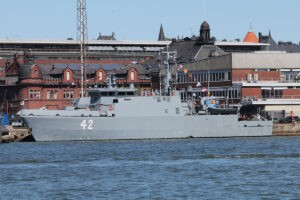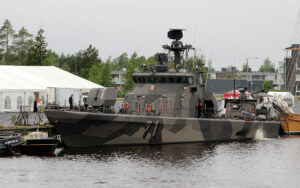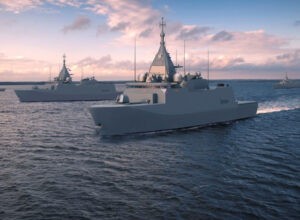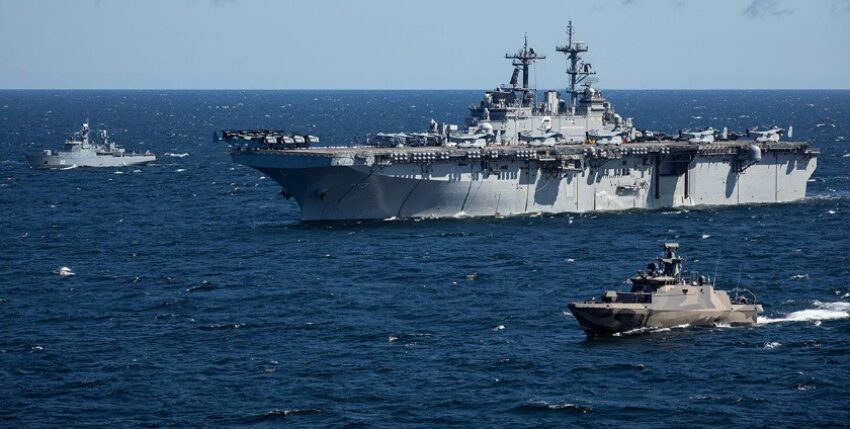For decades, Sweden and Finland were proud of their neutrality. Russia's war of aggression against Ukraine led to a radical rethink. Less than three months after the start of the Russian invasion, the two EU states applied to join NATO.
With an area of 338,472 square kilometres, the Republic of Finland is slightly smaller than the Federal Republic of Germany. However, only 5.5 million people live in this Nordic country. The majority of the Finnish population lives in the catchment area of the major cities of Helsinki, Turku, Oulu and Tampere, while the central and northern parts of the country are very sparsely populated. Finland has a 1344-kilometre land border with the Russian Federation, while only the narrow Gulf of Finland borders directly on Russian territorial waters. Due to this fact, Finland's armed forces are heavily geared towards land and air defence against a potential threat from the east, while the navy plays a significantly subordinate role, but is extremely powerful and is almost exclusively made up of ships and boats built in Finland. The fleet currently comprises eight speedboats and 18 minesweepers as well as smaller amphibious units and landing craft. Due to an agreement concluded during the Paris Peace Conference in 1946, the Finnish navy still has to do without submarines and torpedo boats. In the coming years, four corvettes, each displacing around 3900 tonnes, are to be acquired, enabling autonomous operations outside the Baltic Sea for the first time. Today, around 4000 men and women serve in the country's navy, the Merivoimat.
Historical development

During the centuries when Finland belonged to Sweden, numerous Swedish naval bases were maintained on what is now the Finnish coast. The Finnish War began in 1808 with Russia's attack on Sweden, as a result of which large parts of present-day Finland were ceded to Russia by Sweden in 1809. The Tsarist Empire had already conquered smaller parts of Finland in 1721 and 1743. Russia created the Grand Duchy of Finland from the various Finnish territories, with far-reaching autonomous status, but officially recognised as part of the Russian Empire. During Russian rule from 1809 to 1917, Finland had its own navy called Suomen Meriekipaasi, which had small sailing and steam frigates. After the Russian October Revolution, the Soviet Russian leadership allowed Finland to secede from Russia on 31 December 1917. In the following years, the now independent Finnish navy consisted largely of obsolete gunboats, torpedo boats and minesweepers. In 1927, the Finnish parliament decided to build two modern coastal defence ships, four submarines, new torpedo boats, minesweepers and a training ship. At the beginning of the Second World War, the fleet consisted of two coastal defence ships, five submarines, four gunboats, seven torpedo boats, one minelayer, eight minesweepers and one training ship. The submarines were based on German designs, which were later mass-produced in Germany as Type II and VII with slight modifications. During the war, the Finnish armed forces were initially deployed alongside the German Wehrmacht against the Soviet Union (Winter War 1939-40, Continuation War 1941-44), but after the separate peace with Moscow (concluded on 19 September 1944) they were deployed against the German Reich (Lapland War 1944). Due to its strict neutrality after the Second World War, Finland balanced its arms purchases in the coming decades through contracts with both Western nations and the Soviet Union. Politically at least, however, the country was at times under considerable Soviet influence. During the 1950s and 1960s, a Bay-class frigate, two Dark-class patrol boats and four minesweepers were purchased in the UK, while two Riga-class frigates and four Osa-II-class missile boats were acquired in the Soviet Union. In addition, smaller units such as the Nuoli class speedboats and the Turunmaa class gunboats were built in Finland. The Paris Treaties limited the tonnage of the Finnish navy to 10,000 tonnes and set an upper limit of 4,500 soldiers. Finland was also banned from owning submarines, torpedo boats, mines and missiles. In the 1960s, Finland was finally allowed to own missiles and mines again, and the Finnish navy made extensive use of this by ordering the aforementioned Soviet-made missile boats and manufacturing its own mines. After the end of the Soviet Union, all treaty restrictions on the Finnish Navy were lifted, and it has had torpedoes in its inventory again since 2018.
The Merivoimat today
Merivoimat is currently entrusted with three statutory tasks:
1. surveillance of Finnish territorial waters
2. rejection of territorial violations and maritime attacks
3. protection of sea routes
Its key capabilities include operational command and control and the ability to combat surface and submarine units, maritime reconnaissance, mine laying, mine detection and countermeasures, maritime transport and fire support. Today, the force has bases in Turku, Kirkkonummi, Raseborg and Helsinki.
The Merivoimat is currently led by Rear Admiral Jori Harju. Under his command are 1,400 permanent naval personnel (1,200 military and 200 civilian employees) as well as 3,500 conscripted men (military service of between 5.5 and 12 months) and women doing voluntary military service each year. Since 1995, women between the ages of 18 and 29 have been able to serve voluntarily in the armed forces. The Finnish Navy consists of the Naval Command in Turku and four units at brigade level, the Coastal Flotilla, the Coastal Brigade in Kirkkonummi, which is responsible for amphibious warfare, maritime reconnaissance and special operations, the Nyland Brigade, responsible for training mainly Swedish-speaking personnel as coastal warfare specialists in Raasepori, and the Naval Academy in the sea fortress of Suomenlinna, not far from Helsinki, responsible for training and research. All significant floating naval units are part of the coastal flotilla, which operates primarily from the naval bases of Pansio in the south-west archipelago and Kirkkonummi on the Gulf of Finland. The personnel of the coastal flotilla is made up of 80 per cent professional soldiers and only 20 per cent conscripts. Most of the conscripts serve with the coastal brigade.
Minesweeper
All of the Finnish Navy's minesweepers are based at the 4th Mine Countermeasures Squadron in Pansio. The smallest minesweeper units are the six boats of the Kiiski class (15.8 m, 20 tonnes), Kiiski 1 and Kiiski 3 to 7, which were built between 1981 and 1985 at the Fiskars naval shipyard in Turku and overhauled in the 1990s. A seventh unit, Kiiski 2, has already been decommissioned due to its age. The boats in this class are capable of operating both manned and unmanned - controlled from larger minesweepers.
As early as 1974/75, six units of the 31.6 metre long, 127 tonne displacement Kuha class (Kuha 21 to 26) were built at Oy Laivateollisuus in Turku, of which two units (Kuha 22 and 25) were decommissioned in 2012 for cost reasons. Originally, 14 units were ordered by the Finnish Navy in 1972, but the last eight of these were cancelled before construction began. Since 1983, the Kuha class has been deployed in conjunction with the optionally manned Kiiski class described above. In the 1990s, the Kuha-class boats were thoroughly modernised at the Tyovene shipyard in Uusikaupunki and the hull was lengthened from 26.6 to 36.6 metres in order to accommodate more modern minesweeping equipment. This lengthening of the hull, which is made of glass fibre reinforced plastic, increased the displacement from 91 to 127 tonnes. The crew of the boats, each powered by two Cummins NT-380M diesel engines and travelling at around 12 knots, is usually made up of three officers and twelve ratings. The armament consists of a twin 23-millimetre gun and a 12.7-millimetre machine gun. A Patria Finavitec Sonac HF sonar and a Racal Decca radar are on board for mine detection, supplemented by a Reson Seabat 6012 sonar to prevent mine collisions.

In 2004, the Finnish government announced a comprehensive expansion of its mine countermeasure capabilities and therefore invited bids from several European shipyards for a new generation of minesweepers. Finland received bids from Navantia from Spain, Kockums from Sweden, Lürssen and Abeking & Rasmussen from Germany and Intermarine from Italy, which was finally awarded the contract in November 2006 to build three minesweepers based on the Italian Lerici-class with a contract value of 244.8 million euros. Construction of the first unit, the Katanpää with hull number 40, began in July 2007 and it was commissioned in 2012, followed a year later by its sister ship Purunpää (41) and finally the third unit Vahterpää (42) in 2016. All three minesweepers were transferred to Finland from the shipyard in Sarzana, northern Italy, by heavy transport ship. The hulls of the 52.45 metre long, 680 tonne displacement Katanpää class are made of glass fibre reinforced plastic. The boats are powered by two MTU 8V-396-TE74 diesel engines, each with an output of 1000 kilowatts, in conjunction with two Voith-Schneider propellers. For self-protection, the class is equipped with a 40-millimetre L/70 gun from Bofors. The units are equipped with various autonomous and remote-controlled unmanned underwater vehicles (ROVs and AUVs) and can be individually fitted with a combination of equipment and sensors for each mission, including Klein 5500 towed sonars or Kongsberg EM-710 RD multibeam echosounders. Currently the most modern units in the Finnish Navy, the three Katanpää-class units will remain in service until at least 2040.
Minelayer
In addition to the minesweepers, Finland also has a fleet of five minelayers that were built at Finnish shipyards in the 1990s and are based at the 6th and 7th Anti-Surface Warfare Squadrons in Pansio and Upinniemi.
The three units of the 43-metre-long, 680-tonne displacement Pansio class, Pansio (90), Pyhäranta (92) and Porkkala (91), were commissioned in 1991/92 and are categorised as mine carriers. In order to enable the boats to remain in service into the 2030s, they were completely overhauled between 2015 and 2017 and equipped with new propulsion units. Equipped with PKM 7.62 millimetre calibre machine guns and a 40 millimetre Heckler & Koch automatic grenade launcher, the boats are capable of carrying 50 Finnish Merimiina 2000 mines.
The two 77.8 metre long, 1450 tonne displacement minelayers of the Hämeenmaa class, Hämeenmaa (02) and Uusimaa (05), were built in 1991/92 by Finnyards, which emerged from the Hollming and Rauma shipyards. The two minelayers with steel hulls and aluminium superstructures are still the largest floating units in the navy today; the Hämeenma is therefore the flagship of the Merivoimat. The Hämeenmaa class can operate in waters with an ice density of up to 40 centimetres and is also used as an escort ship and supply vessel in addition to its actual purpose as a minelayer. Between 2006 and 2008, both units were extensively modernised and received a new Saab 9LV325E FCS fire control system and a TRS-3D/16 ES radar from EADS (now Hensoldt). The ships are equipped with a 57-millimetre gun from Bofors, a VLS launch system with eight Umkhonto IR anti-aircraft missiles from the South African defence company Denel, two 12.7-millimetre machine guns, two grenade launchers from H&K, two RBU-1200 depth charge launchers from Russia and tracks for laying up to 150 Merimiina 2000 mines.
High-speed missile boats
The 6th and 7th surface combatant squadrons also include eight missile speedboats. The four 48.5 metre long, 240 tonne displacement Rauma class boats were commissioned between 1990 and 1992. Two units, Rauma (70) and Raahe (71), were still being built at Hollming in Rauma, while two further units, Porvoo (72) and Naantali (73), were already being built under the auspices of Finnyards, which was newly founded in 1991. Two MTU 16V 538 TB93 diesels with 6600 kilowatts of power in combination with two Riva Calzoni IRC 115 waterjets accelerate the boats up to 34 knots. The Rauma class is equipped with a fire control system from Saab, the 9LV225 Mk 4, the Sea Giraffe 9GA 208 search radar from Saab and an ARPA navigation radar from Raytheon. The armament includes a 40-millimetre Bofors gun, two 12.7-millimetre machine guns, six Saab RBS 15 Mk 3 anti-ship missiles and two Saab Elma ASW-600 anti-submarine mortars, while Kongsberg's ST2400 and Finnyard's Sonac/PTA towed sonars are available for submarine detection. In 2015, Finnish media reported for the first time that the navy had decommissioned the four units due to material fatigue. Following shipyard visits for hull repairs in 2016, the boats were delivered back to Merivoimat and are expected to remain in service until the end of the 2020s.

The subsequent four Hamina-class missile boats - Hamina (80), Tornio (81), Hanko (82) and Pori (83) - were built in Rauma in the late 1990s and early 2000s and were originally designated the Rauma-2000 class as a further development of the previous Rauma class. Stealth measures to reduce the radar signature were used for the first time in the ship design of the 51 metre long, 250 tonne displacement Hamina class. Two MTU 16V 538 TB93 diesel engines with 5520 kilowatts of power in combination with two Rolls Royce Kamewa 90SII water jet propulsion systems give the boats a speed of more than 30 knots. The Rauma class is also equipped with a 9LV fire control system from Saab and a TRS-3D/16 ES 3D search radar. During an extensive mid-life upgrade between 2018 and 2022, the 57-millimetre Bofors gun was replaced by a 40-millimetre gun from the same manufacturer for weight reasons and the RBS 15 anti-ship missiles were replaced by Gabriel Mk. 5 from Israel Aerospace Industries (IAI). Eight Umkhonto IR missiles have been fitted for air defence and a rail system for depth charges is available for anti-submarine warfare, which can also be used for mine laying. The mid-life upgrade will enable the Finnish Navy to keep the Hamina class in the fleet until the end of the 2030s.
Other units
In addition to the combatants described above, Merivoimat maintains numerous smaller landing craft of various classes, with lengths between 8 and 20 metres and a maximum displacement of 32 tonnes. It also operates a large number of smaller auxiliary vessels in the form of transporters, command boats, cable carriers, tugs and training boats; small units under 20 metres in length that generally do not leave Finnish coastal waters. Also worth mentioning are the three specialised vessels designed to combat environmental disasters: Hylje (ID 799, 54 m, 1400 tonnes), Halli (ID 899, 61.5 m, 2100 tonnes) and Louhi (ID 999, 71.4 m, 3450 tonnes).
Outlook
In recent years, the demands on the Finnish navy have become ever greater. The construction of four modern corvettes with a length of 114 metres and a displacement of 3900 tonnes is currently being prepared for the Squadron 2020 programme. With these ships, known as the Pohjanmaa class, the navy will have modern units with a helicopter landing deck and hangar and will be able to carry out major operations outside the Baltic Sea for the first time. In September 2019, the construction contract worth 647.6 million euros was signed with Rauma Marine Constructions. Construction was originally scheduled to begin in 2022, but delays in the design process have postponed the start of construction to 2023, probably followed by trials from 2025 and full operational readiness in 2029. The Pohjanmaa class will have ice-breaking capabilities and will replace the two Hämeenmaa-class minelayers and the four Rauma-class missile boats. For the first time, the ships will be powered by a codlag (combined diesel-electric and gas) propulsion system with gas turbines from General Electric in the USA and diesel gensets from MAN Energy Solutions in Germany. In September 2019, Saab was selected as the general supplier of the fire control system and a large number of sensors and effectors for the corvettes. The Swedish defence company will contribute laser warning systems, Sea Giraffe radars and new lightweight torpedoes to Finland's largest naval project to date. The RIM-162 Evolved Sea Sparrow Missile (ESSM) system from Raytheon will be used for air defence and Gabriel V anti-ship missiles will be deployed.
In addition to replacing the older minelayers and fast patrol boats with the Pohjanmaa class, the Finnish Navy is currently looking for a replacement for the ageing Kuha and Kiiski class minesweepers and launched a tender for this purpose on 4 February 2022. They should be able to operate both autonomously and manned and have a maximum length of 24 metres.
Following the arrival of the new corvettes and minesweepers, the Finnish Navy will have an extremely modern fleet, tailored to the geographical and political conditions of Finnish waters, which will also be able to participate in international operations outside the Baltic Sea as part of EU or NATO missions.
From Stefan Ulsamer








